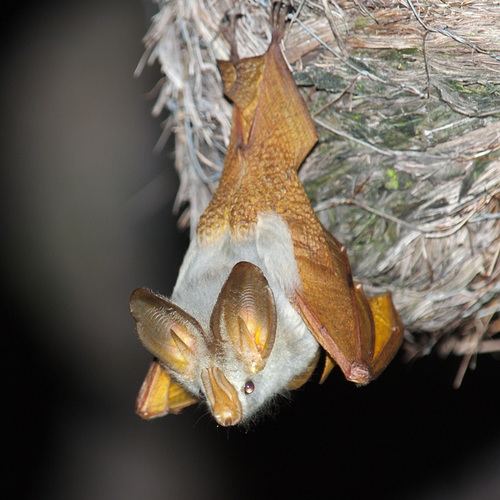
Yellow-winged bat
The Yellow-winged Bat (*Lavia frons*) is a visually striking bat species found in sub-Saharan Africa. It's not actually a 'bat' in the traditional sense, belonging to the family of false vampire bats. It is known for its bright yellow or orange wing membranes and ears, which contrast sharply with its greyish-brown fur. This bat plays an important ecological role as an insectivore, helping to control insect populations. It is a relatively common species, although it faces some threats from habitat loss. It holds no particular cultural significance in most areas, though its striking appearance often makes it a subject of local interest.
5.8-8 cm
Length
30-36 cm
Wingspan
Least Concern
Conservation Status
Distribution
Found across sub-Saharan Africa, from Senegal in the west to Kenya in the east, and south to northern Zambia and Malawi. It is absent from the dense rainforests of the Congo Basin and the arid regions of the Horn of Africa. It has no significant migratory patterns.
Lifespan
Unknown in the wild; likely several years based on similar-sized bat species.
Yellow-winged bat's Habitat
Habitat Types
Savannas, Woodlands, Shrublands, Riparian forests (forests along rivers)
Climate Zones
Tropical, Subtropical
Adaptations
Their broad wings allow for maneuverable flight, essential for hunting insects in dense vegetation. They have been observed using thorny acacias as roosting sites, suggesting some adaptation to thorny environments.
Variations
No recognized subspecies, but there may be slight regional variations in size and coloration that have not been formally documented.
Appearance
Breeding Plumage
No significant seasonal changes in fur or membrane color.
Seasonal Feather Changes
None
Sex Based Plumage Differences
Minimal; males and females have similar coloration.
Notable Features
Bright yellow or orange wing membranes, Large, yellow or orange ears, Leaf-like nose, used for echolocation, Long tragus (projection inside the ear)
Diet and Feeding
Primary Foods
Large insects, Beetles, Moths, Grasshoppers
Foraging Behavior
A 'sit-and-wait' predator. It perches on a branch, using its excellent eyesight and hearing to detect prey, then makes short flights to capture insects in the air or on foliage. They often return to the same perch.
Specializations
Highly maneuverable flight allows for capturing insects in dense vegetation. Large ears and nose-leaf enhance echolocation, although vision is also important.
Seasonal Diet Variations
Diet likely varies depending on insect availability, with a broader range of prey taken during periods of insect abundance.
Behavior
Social Structure
Usually found in monogamous pairs or small family groups consisting of a pair and their recent offspring.
Communication
Echolocation calls for navigation and prey detection, Audible chirps and squeaks for social communication
Migration
Non-migratory; they are resident within their range.
Territorial or Group Behaviors
Monogamous pairs defend a small territory around their roosting and foraging sites. They are known to be quite aggressive towards other Yellow-winged Bats that enter their territory.
Conservation
Threats
Habitat loss due to agriculture and deforestation, Pesticide use reducing insect prey availability
Protection Programs
None specifically for this species, but it benefits from general habitat protection measures within its range.
Local National Laws
Protected under general wildlife legislation in many African countries, but enforcement may be limited.
Population Trend
Stable
Population Estimates
No precise global population estimate, but considered relatively common within its range.
Interesting Facts
They are one of only five bat species on the African continent that are brightly colored.
Most bats are brown or grey; the yellow wings of this species are unusual.
They are sometimes called 'false vampire bats' because they don't feed on blood.
Their family, Megadermatidae, includes species that eat insects, small vertebrates, and even other bats, but not blood.
They often roost in thorny acacia trees.
The thorns may offer protection from predators.
Unlike many bat species, they rely heavily on sight, in addition to echolocation.
They use their large eyes to spot prey at dusk and dawn.
Faqs about Yellow-winged bat
Do Yellow-winged Bats carry rabies?
Like any mammal, they can potentially carry rabies, but they are not a major reservoir for the disease. It's always best to avoid handling any wild animal.
Are Yellow-winged Bats blind?
No, they have good eyesight, which they use for hunting.
Are Yellow-winged Bats aggressive?
They are territorial and can be aggressive towards other Yellow-winged Bats, but they are not typically aggressive towards humans unless threatened.
What eats Yellow-winged bats?
Predators likely include owls, snakes, and other larger carnivorous animals.
Copyright @ Nature Style Limited. All Rights Reserved.
 English
English